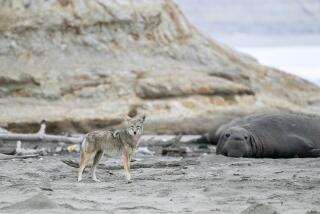Hawaiian Monk Seal Being Pushed Toward Extinction
- Share via
HONOLULU — One of the world’s most endangered species of seal is being pushed toward extinction by humans disturbing their breeding grounds, trashing their ocean and catching the lobsters that feed their pups.
And efforts to save the Hawaiian monk seal are threatened by the Navy’s plan to test new missile defense systems off Kauai, near where the seals haul themselves onto the beach, the Marine Mammal Commission says.
With a population of no more than 1,400, the Hawaiian monk seal is the most endangered seal in U.S. waters. Its population has declined by at least half since the 1950s.
Last year, researchers at the seals’ prime breeding ground at French Frigate Shoals counted 97 pups early in the season. Months later, at least 63 had died or were presumed dead.
“Monk-seal recovery has been and continues to be a challenging task,” the commission reported to Congress in January.
The major breeding colonies for Hawaiian monk seals are on the remote northwestern Hawaiian islands of French Frigate Shoals, Laysan Island, Lisianski Island, Pearl and Hermes Reef, and Kure Atoll. A few births also occur at Midway Atoll, Necker Island, Nihoa and Niihau.
Several of those islands contain military installations.
A few seals also are found off the main Hawaiian islands of Hawaii, Maui, Lanai, Molokai, Oahu, Kauai and Niihau.
The commission said human disturbance forces the seals off their pupping and haul-out beaches, disrupting mother-pup bonds, causing premature weaning and making pups less able to survive on their own. The seals also may be forced to choose pupping sites more vulnerable to extreme weather, high surf or predation by tiger sharks.
In addition, the seals are threatened by debris and trash dropped into the ocean. “Trash generated by human activities . . . poses a serious risk of injury and mortality to monk seals at all major breeding colonies,” the report says. “Monk seals actively seek out and interact with such debris.”
The most deadly is netting lost or discarded by commercial fishermen. Much of that drifts from Asia; there are no commercial fisheries around the island.
Under federal law, the National Marine Fisheries Service protects Hawaiian monk seals. Early last year, it surveyed shallow waters off French Frigate Shoals and found the equivalent of 94 net fragments per square kilometer of reef.
Researchers studying the breeding colonies counted 16 seals caught in debris, with one dead. The actual numbers probably are greater since researchers were there only a short time.
“That’s why marine debris is such an important issue to us,” said Bud Antonelis, chief of the National Marine Fisheries Service’s protected species investigation unit. “That’s a factor we clearly can do something about.”
Antonelis has spent 27 years studying seals and said the Hawaiian monk “is a very special species.” Relatives of the current seal population have been traced back 15 million years, making them the oldest living pinnipeds.
Adults can grow to 7 feet, weigh 600 pounds and live to 30 years.
But NMFS has rejected repeated commission requests to close the lobster fishery around the northwestern Hawaiian islands. The commission said research shows that lobsters are part of the seals’ diet, while other research shows that the fishery is being depleted.
Antonelis said the seals eat more than lobsters, including bottom fish and octopus, and food availability may be influenced by oceanographic conditions.
Looming in the future is the Navy’s plan to expand and upgrade its Pacific Missile Range Facility on western Kauai. The commission said the seals haul themselves out on the Kauai beach and also at the Navy’s proposed support facility on Niihau. So testing--launches, explosions and dredging--could “prevent the population recovery in the foreseeable future and substantially increase its risk of extinction.”
The Navy said seals have been seen at the range, but seal pupping has not. As for Niihau, seals use the beach to haul out, bask and pup.
The Navy said its plans must be approved by numerous federal and state agencies before any testing.
“The Navy’s not going to do anything that’s going to threaten an endangered species,” Lt. Cmdr. Rod Gibbons said. “We don’t want to do anything that’s wrong.”
More to Read
Sign up for Essential California
The most important California stories and recommendations in your inbox every morning.
You may occasionally receive promotional content from the Los Angeles Times.













